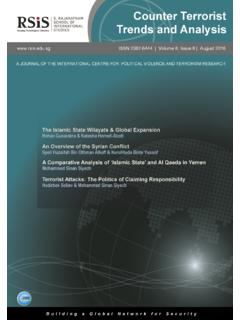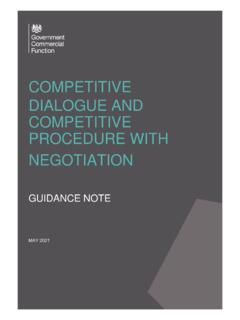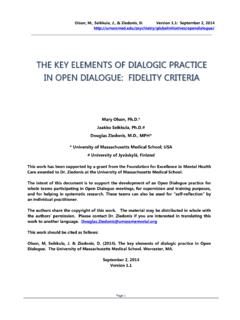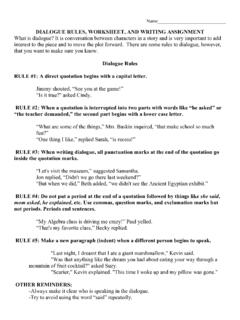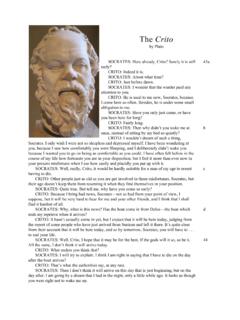Transcription of THE QUADRILATERAL SECURITY DIALOGUE
1 Nanyang Technological UniversityBlock S4, Level B3, 50 Nanyang Avenue, Singapore 639798 Tel: +65 6790 6982 | Fax: +65 6794 0617 | QUADRILATERAL SECURITY DIALOGUE :TOWARDS AN INDO-PACIFIC ORDER? Policy Report September 2019H. D. P. EnvallPOLICY REPORTTHE QUADRILATERAL SECURITY DIALOGUE :TOWARDS AN INDO-PACIFIC ORDER? H. D. P. EnvallSeptember 2019 TABLE OF CONTENTSE xecutive Summary 1 Introduction 2 Background and Trajectory 3A Case of Coinciding Interests?
2 4 Cooperation: Opportunities or Obstacles? 6 Future Prospects 8 About the Author 10 About the Institute of Defence and Strategic Studies 11 About the S. Rajaratnam School of International Studies 111 EXECUTIVE SUMMARY The QUADRILATERAL SECURITY DIALOGUE , or Quad, was reborn in 2017 to secure a rules-based order in the Indo-Pacific. Bringing together the US, Japan, India, and Australia, the Quad was initially intended as a mechanism for responding to the 2004 Indian Ocean tsunami. However, it quickly became entangled in growing strategic competition across Asia and collapsed in 2008.
3 Although the four countries still sometimes differ in their views of the region s strategic trends, the Quad s revival points to a greater alignment of interests this time around. Nonetheless, major challenges to the Quad s viability remain. First, it is unclear whether the four powers will be able to maximise opportunities for cooperation while ensuring that wider geopolitical rivalries do not again overwhelm the grouping. Second, given that it has been revived to support this Indo-Pacific order, the Quad is constrained by the vagueness of the Indo-Pacific concept and the absence of revised Quad the 2017 update of the informal QUADRILATERAL SECURITY DIALOGUE originally formed by the US, Japan, India, and Australia in 2007 represents a renewed attempt to shore up a rules-based order in the Indo-Pacific.
4 1 Yet the Quad s resurrection raises more questions than it answers. These relate not only to its members aims and interests. They also touch on questions concerning what the Indo-Pacific means as a region, why it requires further institutional support, and whether the Quad is the right institution. This paper begins by outlining the Quad s background, before examining the respective interests of its partners. It then draws out the specific areas for likely cooperation and potential obstacles. Finally, it concludes with an assessment of the Quad s prospects. The policy brief argues that, while opportunities exist for future low-key cooperation, a significant risk is that larger geopolitical rivalries will overwhelm such opportunities.
5 Further, as an attempt to support an Indo-Pacific order, the Quad is ultimately constrained by the vagueness of the Indo-Pacific concept and the absence of Indonesia. 1 Australian Department of Foreign Affairs and Trade (DFAT), Australia-India-Japan-United States Consultations on the Indo-Pacific, media release, November 12, 2017, AND TRAJECTORYQ uadrilateral cooperation was initially borne out of a natural disaster the Indian Ocean tsunami of December 2004. One such response was the Tsunami Core Group established by the US, Japan, Australia, and India to facilitate coordination of relief activities. This group was intended to address the immediate challenges presented by the tsunami and its aftermath, and so was never meant to be But the QUADRILATERAL idea soon evolved into something Japan was keen to establish values-based connections in order to create an arc of freedom and prosperity through the Accordingly, on the sidelines of the Association of Southeast Asian Nations (ASEAN) Regional Forum summit held in the Philippines in August 2007, the four nations met to discuss options for further engagement.
6 Later that year, they participated, along with Singapore, in major naval exercises, a development which drew criticism from However, these early efforts at cooperation immediately raised tensions over the Quad s overarching purpose. By 2008, Australia had expressed concerns about the Quad and its impact on Sino-Australian relations and had withdrawn from further DIALOGUE of that nature. 6 India, too, was worried about the impact the Quad might have on its own foreign Enthusiasm for the Quad subsequently dissipated, and the idea largely disappeared from national diplomacy. Yet the Quad was not dead but merely in hiatus. By 2017, a renewed interest in the DIALOGUE had As such, the four countries restarted their DIALOGUE , meeting once again in the 2 Marc Grossman, The Tsunami Core Group: A Step toward a Transformed Diplomacy in Asia and Beyond, SECURITY Challenges 1, no.
7 1 (2005), 11 14, at 11 12. See also H. D. P. Envall, Community Building in Asia? Trilateral Cooperation in Humanitarian Assistance and Disaster Relief, in Yuki Tatsumi (ed.), US-Japan-Australia SECURITY Cooperation: Prospects and Challenges (Washington, DC: Stimson Center, 2015), 51 59, at Tanvi Madan, The Rise, Fall, and Rebirth of the Quad , War on the Rocks, November 16, 2017, Taro Aso, Arc of Freedom and Prosperity: Japan s Expanding Diplomatic Horizons, speech on the Occasion of the Japan Institute of International Affairs Seminar, November 30, 2006, Ramesh Thakur, Australia and the Quad, Strategist, July 5, 2018, For China s response, see Brendan Nicholson, China Warns Canberra on SECURITY Pact, Age, June 15, 2007, # Stephen Smith, Joint Press Conference with Chinese Foreign Minister, February 5, 2008, See also Frank Ching, Asian Arc Doomed without Australia, Japan Times, February 22, 2008, Madan, The Rise, Fall, and Rebirth of the Quad.
8 8 Thakur, Australia and the Quad. 4 Philippines, this time on the sidelines of the East Asia Summit. Later, they promised to pursue continuing discussions and deepening cooperation based on shared values and principles. 9 The Quad, as Ankit Panda put it, was back. 10 A CASE OF COINCIDING INTERESTS? Euan Graham argues that the future of the new Quad will be shaped primarily by the degree to which there is alignment between the four partners threat perceptions and national But what are these interests? And do they now coincide? The Quad s long hiatus shows that these interests have not always aligned, with China at the heart of many of the Quad s differences.
9 Indeed, that Australia baulked in 2008 highlights China s growing capacity to shape the strategic choices of countries around Asia, leading to doubts amongst the other parties, especially India, over Australia s strategic positioning in the Still, Australia has not been the only Quad partner to have struggled in this respect. In 2009 2010, Japan explicitly sought to move closer to Asia, especially China, but its policy collapsed with the worsening of Sino-Japanese relations from Greater alignment exists this time around, although differences persist. The US grand strategy is confused by the presidency of Donald Trump but still exhibits a strong focus on maintaining its regional hegemony and resisting China s Japan and India are also seeking to maintain or advance their own regional leadership, check Chinese power, and where possible hedge between the US and For Australia, as the Quad s lone middle power, building closer relations with the great powers of the Indo-Pacific has long been viewed as an important national interest.
10 Australia 9 DFAT, Australia-India-Japan-United States Consultations on the Indo-Pacific. 10 Ankit Panda, US, Japan, India, and Australia Hold Working-Level QUADRILATERAL Meeting on Regional Cooperation, Diplomat, November 13, 2017, Euan Graham, The Quad Deserves its Second Chance, in Andrew Carr (ed.), Debating the Quad, Centre of Gravity series paper 39 (Canberra: Strategic and Defence Studies Centre, ANU, 2018), 4 7, at Madan, The Rise, Fall, and Rebirth of the Quad ; Thakur, Australia and the Quad. 13 H. D. P. Envall, Clashing Expectations: Strategic Thinking and Alliance Mismanagement in Japan, in Yoichiro Sato and Tan See Seng (eds.)
